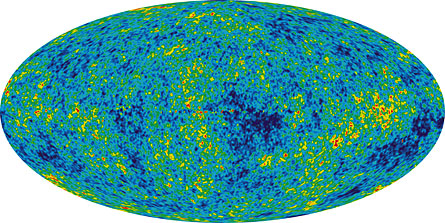For a group of scientists who profess to love the symmetries in nature, cosmologists and astronomers spend an awful lot of time looking for and analyzing imbalances in the cosmic architecture.

A new study, reported in the Dec. 16 Physical Review Letters, seeks to explain why half of the sky appears to have larger deviations from the average temperature of the radiation in the cosmic microwave background, the remnant heat left over from the Big Bang, than the other half does.
The lopsided distribution in temperature may provide new insights about the earliest moments in the universe, when the cosmos underwent a brief but enormous growth spurt, expanding from subatomic scales to something the size of a soccer ball in just a tiny fraction of a second. It also suggests that the distribution of galaxies in the sky today — how closely they cluster — may exhibit subtle variations linked to differences in those early moments.
Researchers have known since 1992 that the microwave background is riddled with tiny temperature variations. These relatively hot and cold spots mark fluctuations in the density of the infant universe that ultimately gave rise to the population of galaxies seen today.
But it’s only recently, using data from NASA’s Wilkinson Microwave Anisotropy Probe, or WMAP, that astronomers have found hints that the contrast between hotter and colder temperatures in the microwave background is more pronounced on one side of the sky than on the other.
Marc Kamionkowski, Adrienne Erickcek and Sean Carroll, all of the California Institute of Technology in Pasadena, take this temperature asymmetry as a given, although its statistical significance remains under debate.
The early era of hyperexpansion, known as inflation, can explain many features of the modern-day universe, including the general uniformity over regions of the sky that are today separated by vast distances.
In the simplest model of the inflation of the universe, a field called the inflaton plays two roles. It provides the energy that drives the expansion and also generates the seeds of galaxy formation: quantum density fluctuations that enlarge to become the hot and cold spots in the microwave background. This simple model, however, doesn’t reproduce the apparent asymmetry actually observed with WMAP, Kamionkowski says.
To account for the asymmetry, Kamionkowski and his colleagues propose that the inflaton has a more limited role. It would only provide the energy that drives cosmic inflation. A separate field, called the curvaton and proposed by other theorists about six years ago, would act as a silent spectator during expansion. But just afterward, quantum fluctuations in the curvaton field would convert to the fluctuations in density from which researchers believe galaxies arose.
“This idea gives you a bit more freedom in constructing models, as you have separated out the requirements to get sufficient inflation from the requirements to get appropriate density fluctuations,” says Carroll. “That was crucial to our model,” he adds.
With just a single field, the inflaton, having to do two jobs — providing the energy to both drive inflation and to generate initial density fluctuations — it’s impossible to get both the asymmetry between the different halves of the sky and the actual magnitude of the tiny temperature differences observed in the microwave background, Carroll says. Any asymmetry that would be attained with just the inflaton field would come with larger deviations within the microwave background from the average temperature than is actually measured.
If the curvaton exists, it would produce a different pattern of primordial density fluctuations than the simplest model of inflation would. Those fluctuations, imprinted on in the cosmic microwave background, are too small to be found by the Wilkinson Microwave Anisotropy Probe but they would be readily detected by the European Space Agency’s Planck mission, now scheduled for launch in April 2009, Kamionkowski says. In addition, those differences in the primordial fluctuations may produce a larger clustering of galaxies on one side of the universe than the other, for which future telescope surveys could search.
Princeton cosmologist David Spergel says he finds the Caltech study intriguing but cautions that published studies only reveal the asymmetry over large scales, comparing patches of sky larger than the area of the full moon. “It’s important to show that the [apparent] asymmetry is independent of scale,” he says, “…so the statistical significance of the asymmetry is controversial.”







